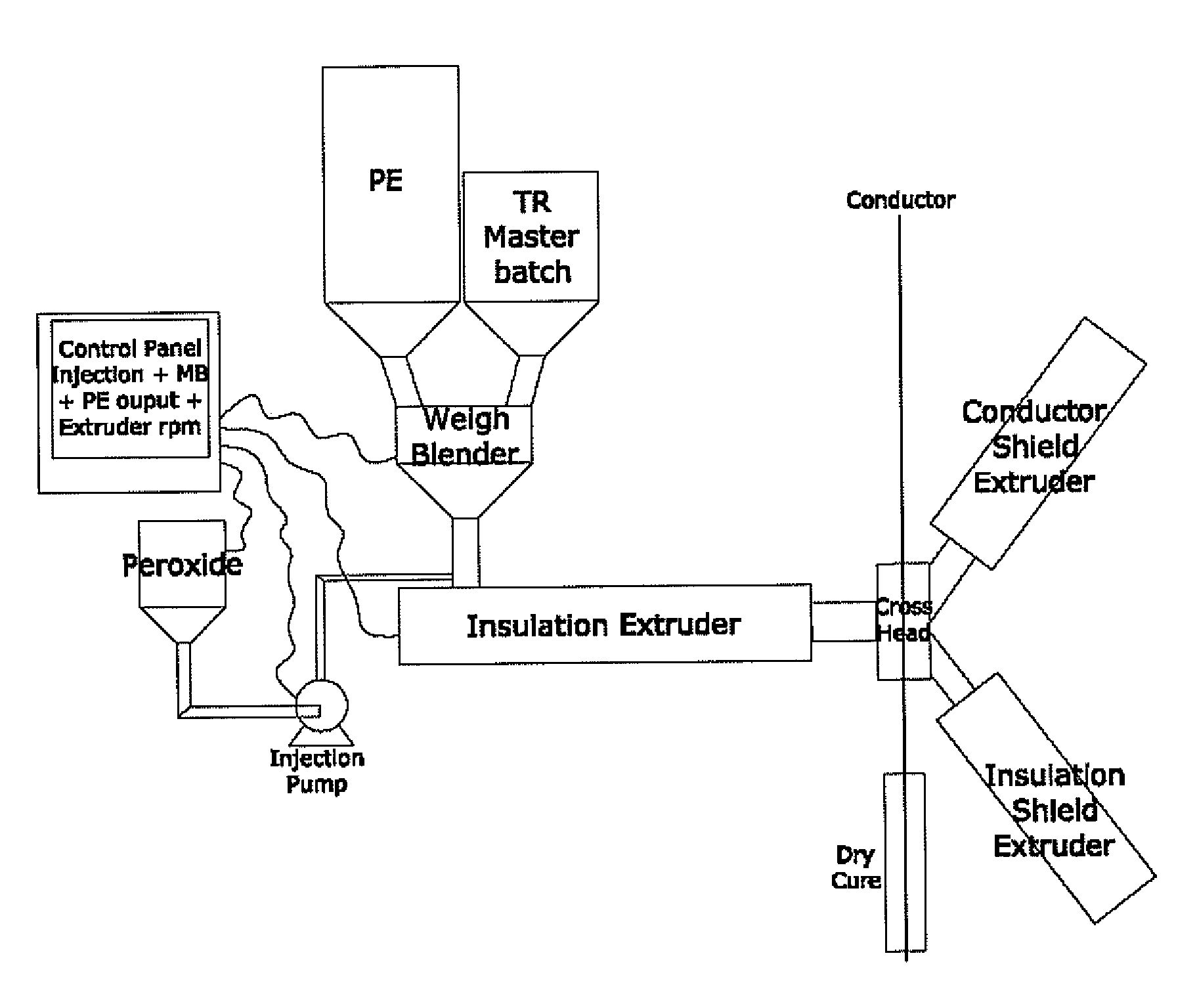Tree resistant insulation compositions
a technology of compositions and insulation compositions, applied in the field of insulation compositions, can solve the problems of buried power cables being especially vulnerable to water treeing, the actual breakdown of the modular structure of dielectric materials, and the failure of polymeric power cable insulation to undergo treeing, etc., and achieve the effect of improving tree resistan
- Summary
- Abstract
- Description
- Claims
- Application Information
AI Technical Summary
Benefits of technology
Problems solved by technology
Method used
Image
Examples
example 1
Description of Master Batches and Formulas
[0097]The manufacturing of masterbatches or formulas was done in two steps: premixing additives with polyethylene pellets, dispersing additives into molten polyethylene, and pelletizing. At the premixing stage, antioxidant, PEG and Hals were premixed in a 55 gallon tumble-blender for 30 minutes, and then polyethylene LD 419 pellets were added to the mixture and all ingredients were mixed for another 30 minutes. The premixing composition was fed to an L / D 24:1 intermeshing co-rotating twin-screw extruder to make the insulation materials. The melting temperature was maintained at 324° F., and the screw speed maintained 150-180 rpm. The finished insulation compounds was pelletized through a 24 hole strand Pelletier die. The following materials were used:
Polymers
[0098]ExxonMobil LDPE, LD 419.MV, a polyethylene homopolymer, CAS number 9002-88-4, melt index 2.25g / 10 min, density 0.921 g / cm3, peak melting temperature 228° F. (109° C.). LD 419 MV is...
example 2
Description of Peroxide Injection Process
[0111]The peroxide injection system is shown in FIG. 1. If solid dicumyl peroxide is used, it must be melted in peroxide container in a 130° F. hot bath prior to injection. Melt dicumyl peroxide or liquid trigonox 101 peroxide with or without liquid Irgastab Cable KV 10 is dosed to polyethylene, if no masterbatch is added, by pumping them directly into the hopper by means of stroke head, located in the bottom part of the hopper. The peroxide injection speed is automatically adjusted by injection control panel based on the primary insulation extruder speed. The spray method provides good mixing of the liquid additives with polyethylene at an early stage. Coarse mixing takes place when the additives are directly introduced into the hopper, followed by intensive mixing in the melting zone and especially in the mixing zone of the extruder.
example 3
Square Wire Tests
[0112]Square 14 gauge copper conductor wires with 30 mils of insulation were extruded with a 20:1 LD Davis standard extruder and a crosshead die and cured in steam at 400° F. Eight to ten 25 inch samples of these insulated square conductor wires were placed in a 75° C. water bath and energized with 7500 volts. Time to short circuit was recorded. The purpose of the square conductor is to create an electrical stress concentration at each corner and accelerate time to failure.
Accelerating Cable Life Test (ACLT)
[0113]The power cables tested were prepared in accordance with the formulations listed in Table 1. The cables had a 1 / 0 19 wire stranded aluminum conductor surrounded by 15 mils of a conductor shield, surrounded by either 60 or 175 mils of polyethylene insulation as specified in Table 1 (representing the parts by weight) surrounded by 35 mils. of semiconductive insulation shield. A copper mesh was then wrapped around the insulation shield to provide the ground pa...
PUM
| Property | Measurement | Unit |
|---|---|---|
| time to failure | aaaaa | aaaaa |
| time to failure | aaaaa | aaaaa |
| dielectric constant | aaaaa | aaaaa |
Abstract
Description
Claims
Application Information
 Login to View More
Login to View More - R&D
- Intellectual Property
- Life Sciences
- Materials
- Tech Scout
- Unparalleled Data Quality
- Higher Quality Content
- 60% Fewer Hallucinations
Browse by: Latest US Patents, China's latest patents, Technical Efficacy Thesaurus, Application Domain, Technology Topic, Popular Technical Reports.
© 2025 PatSnap. All rights reserved.Legal|Privacy policy|Modern Slavery Act Transparency Statement|Sitemap|About US| Contact US: help@patsnap.com


